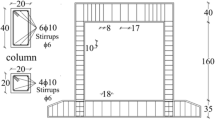Abstract
The most important aspects of the design, seismic damage evaluation and safety assessment of structures with low ductility like waffle slabs buildings or flat beams framed buildings are examined in this work. These reinforced concrete structural typologies are the most used in Spain for new buildings but many seismic codes do not recommend them in seismic areas. Their expected seismic performance and safety are evaluated herein by means of incremental non linear structural analysis (pushover analysis) and incremental dynamic analysis which provides capacity curves allowing evaluating their seismic behavior. The seismic hazard is described by means of the reduced 5% damped elastic response spectrum of the Spanish seismic design code. The most important results of the study are the fragility curves calculated for the mentioned building types, which allow obtaining the probability of different damage states of the structures as well as damage probability matrices. The results, which show high vulnerability of the studied low ductility building classes, are compared with those corresponding to ductile framed structures.
Similar content being viewed by others
References
ACI Comitee 318 (2005) Building code requirements for structural concrete ACI 318–05. Farmington Hills, Michigan
Barbat AH, Oller S, Mata P, Vielma JC (2008) Computational simulation of the seismic response of buildings with energy dissipating devices. In: Papadrakakis M, Charmpis D, Lagaros N, Tsompanakis Y (eds) Computational structural dynamics and earthquake engineering, vol 2. Taylor & Francis Ltd, London, pp 255–274
Car E, Oller S, Oñate E (2000) An anisotropic elasto plastic constitutive model for large strain analysis of fiber reinforced composite materials. Comput Methods Appl Mech Eng 185(2–4): 245–277. doi:10.1016/S0045-7825(99)00262-5
Car E, Oller S, Oñate E (2001) A large strain plasticity for anisotropic materials: composite material application. Int J Plast 17(11): 1437–1463. doi:10.1016/S0749-6419(00)00098-X
CEN (2001) European Committee for Standardization, Eurocode 2: Design of concrete structures, BS EN 1992, Brussels
CEN (2004) European Committee for Standardization, Eurocode 8: Design of structures for earthquake resistance, Part 1: General rules, seismic actions and rules for buildings, EN 2004-1-1, Brussels
EHE (1998) Comisión permanente del hormigón estructural, Instrucción de hormigón estructural, Madrid
Erberik A, Elnashai A (2006) Loss estimation analysis of flat-slab structures. J Struct Eng 7(1): 26–37
Fajfar P (2000) A nonlinear analysis method for perfomance based seismic design. Earthq Spectra 16: 573–591. doi:10.1193/1.1586128
Fragiacomo M, Amadio C, Rajgelj S (2006) Evaluation of the structural response Ander seismic actions using non-linear static methods. Earthq Eng Struct Dynam 35: 1511–1531. doi:10.1002/eqe.597
Han SW, Chopra A (2006) Approximate incremental dynamic analysis using the modal pushover analysis procedure. Earthq Eng Struct Dynam 35(3): 1853–1873. doi:10.1002/eqe.605
ICBO (1997) International Council of Building Officials. Uniform Building Code (UBC), Whittier
ICC (2003) International Code Council. International Building Code (IBC), Falls Church
Kunnath S (2005) Performance-based seismic design and evaluation of buildings structures. In: Chen W, Lui E (eds) Earthquake engineering for structural design. CRC Press, Boca Raton
Mander JB, Priestley MJN, Park R (1988) Observed stress-strain behavior of confined concrete. J Struct Eng 114(8): 1827–1849. doi:10.1061/(ASCE)0733-9445(1988)114:8(1827)
Mata P, Oller S, Barbat AH (2007) Static analysis of beam structures under nonlinear geometric and constitutive behavior. Comput Methods Appl Mech Eng 196: 4458–4478. doi:10.1016/j.cma.2007.05.005
Mata P, Oller S, Barbat AH (2008a) Dynamic analysis of beam structures under nonlinear geometric and constitutive nonlinearity. Comput Methods Appl Mech Eng 197: 857–878
Mata P, Oller S, Barbat AH, Boroschek R (2008b) Constitutive and geometric nonlinear models for the seismic analysis of RC structures with energy dissipators. Arch Comput Methods Eng 15: 489–539. doi:10.1007/s11831-008-9024-z
Mwafi A, Elnashai A (2002a) Overstrength and force reduction factors of multistorey reinforced-concrete buildings. Struct Des Tall Build 11: 329–351. doi:10.1002/tal.204
Mwafi AM, Elnashai A (2002b) Calibration of force reduction factors of RC buildings. J Earthq Eng 6(2): 239–273. doi:10.1142/S1363246902000723
NCSE-02 (2002) Norma de construcción sismorresistente, BOE N◦ 244, Madrid. Available via http://www.proteccioncivil.es/es/Galerias/Descargas/DGPCE/legisla/NCSR-02.pdf. Accessed 20 May 2009
Park R (1988) State-of-the-art report: ductility evaluation from laboratory and analytical testing. In: Proceedings of 9th WCEE, IAEE, vol VIII. Tokyo-Kyoto, Japan, pp 605–616
Pinto PE, Giannini R, Franchin P (2006) Seismic reliability analysis of structures. IUSS Press, Pavia
PLCd (1991–2009) Non-linear thermo mechanic finite element code oriented to PhD student education, code developed at CIMNE
Priestley MJN, Calvi GM, Kowalsky MJ (2007) Displacement-based seismic design of structures. IUSS Press, Pavia
SEAOC (1995) Vision 2000. Report on performance based seismic engineering of buildings vol I. Structural Engineers Association of California, Sacramento
Simo JC (1985) A finite strain beam formulation. The three-dimensional dynamic problem. Part I. Comput Methods Appl Mech Eng 49: 55–70
Vamvatsikos D, Cornell CA (2002) Incremental dynamic analysis. Earthq Eng Struct Dynam 31(3): 491–514
Vielma JC (2008) Caracterización de la respuesta sísmica de edificios de hormigón armado mediante la respuesta no lineal. PhD Thesis, Universitat Politecnica de Catalunya, Spain
Vielma JC, Barbat AH, Oller S (2006) Comparación entre los factores de reducción de respuesta de la norma NCSE-02 y del Eurocódigo 8. Hormigón y acero 246: 79–95
Vielma JC, Barbat AH, Oller S (2009) Seismic preformance of Waffled-Slab floor buildings. Proc P I Civil Eng-Str (in press)
Author information
Authors and Affiliations
Corresponding author
Rights and permissions
About this article
Cite this article
Vielma, J.C., Barbat, A.H. & Oller, S. Seismic safety of low ductility structures used in Spain. Bull Earthquake Eng 8, 135–155 (2010). https://doi.org/10.1007/s10518-009-9127-4
Received:
Accepted:
Published:
Issue Date:
DOI: https://doi.org/10.1007/s10518-009-9127-4




